Samsung SSD 840 EVO Review: 120GB, 250GB, 500GB, 750GB & 1TB Models Tested
by Anand Lal Shimpi on July 25, 2013 1:53 PM EST- Posted in
- Storage
- SSDs
- Samsung
- TLC
- Samsung SSD 840
AnandTech Storage Bench 2011
Two years ago we introduced our AnandTech Storage Bench, a suite of benchmarks that took traces of real OS/application usage and played them back in a repeatable manner. I assembled the traces myself out of frustration with the majority of what we have today in terms of SSD benchmarks.
Although the AnandTech Storage Bench tests did a good job of characterizing SSD performance, they weren't stressful enough. All of the tests performed less than 10GB of reads/writes and typically involved only 4GB of writes specifically. That's not even enough exceed the spare area on most SSDs. Most canned SSD benchmarks don't even come close to writing a single gigabyte of data, but that doesn't mean that simply writing 4GB is acceptable.
Originally I kept the benchmarks short enough that they wouldn't be a burden to run (~30 minutes) but long enough that they were representative of what a power user might do with their system.
Not too long ago I tweeted that I had created what I referred to as the Mother of All SSD Benchmarks (MOASB). Rather than only writing 4GB of data to the drive, this benchmark writes 106.32GB. It's the load you'd put on a drive after nearly two weeks of constant usage. And it takes a *long* time to run.
1) The MOASB, officially called AnandTech Storage Bench 2011 - Heavy Workload, mainly focuses on the times when your I/O activity is the highest. There is a lot of downloading and application installing that happens during the course of this test. My thinking was that it's during application installs, file copies, downloading and multitasking with all of this that you can really notice performance differences between drives.
2) I tried to cover as many bases as possible with the software I incorporated into this test. There's a lot of photo editing in Photoshop, HTML editing in Dreamweaver, web browsing, game playing/level loading (Starcraft II & WoW are both a part of the test) as well as general use stuff (application installing, virus scanning). I included a large amount of email downloading, document creation and editing as well. To top it all off I even use Visual Studio 2008 to build Chromium during the test.
The test has 2,168,893 read operations and 1,783,447 write operations. The IO breakdown is as follows:
| AnandTech Storage Bench 2011 - Heavy Workload IO Breakdown | ||||
| IO Size | % of Total | |||
| 4KB | 28% | |||
| 16KB | 10% | |||
| 32KB | 10% | |||
| 64KB | 4% | |||
Only 42% of all operations are sequential, the rest range from pseudo to fully random (with most falling in the pseudo-random category). Average queue depth is 4.625 IOs, with 59% of operations taking place in an IO queue of 1.
Many of you have asked for a better way to really characterize performance. Simply looking at IOPS doesn't really say much. As a result I'm going to be presenting Storage Bench 2011 data in a slightly different way. We'll have performance represented as Average MB/s, with higher numbers being better. At the same time I'll be reporting how long the SSD was busy while running this test. These disk busy graphs will show you exactly how much time was shaved off by using a faster drive vs. a slower one during the course of this test. Finally, I will also break out performance into reads, writes and combined. The reason I do this is to help balance out the fact that this test is unusually write intensive, which can often hide the benefits of a drive with good read performance.
There's also a new light workload for 2011. This is a far more reasonable, typical every day use case benchmark. Lots of web browsing, photo editing (but with a greater focus on photo consumption), video playback as well as some application installs and gaming. This test isn't nearly as write intensive as the MOASB but it's still multiple times more write intensive than what we were running in 2010.
As always I don't believe that these two benchmarks alone are enough to characterize the performance of a drive, but hopefully along with the rest of our tests they will help provide a better idea.
The testbed for Storage Bench 2011 has changed as well. We're now using a Sandy Bridge platform with full 6Gbps support for these tests.
AnandTech Storage Bench 2011 - Heavy Workload
We'll start out by looking at average data rate throughout our new heavy workload test:
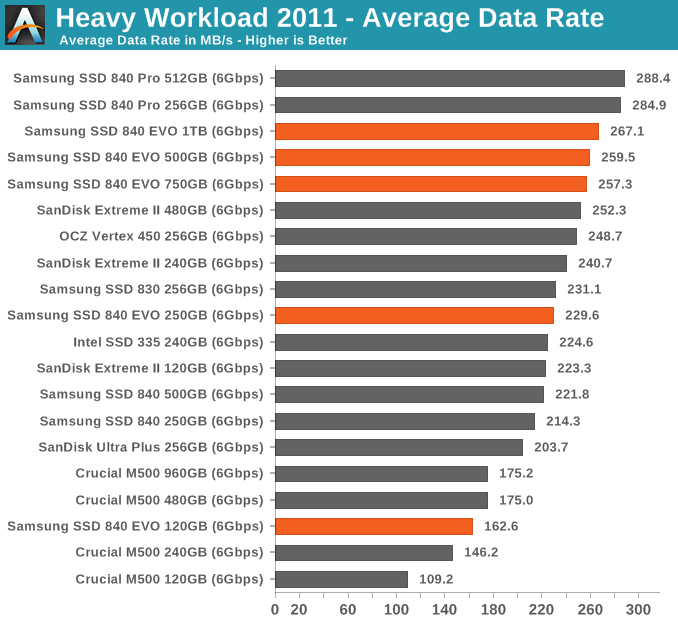
In lighter workloads than our 2013 workload the EVO still does incredibly well.
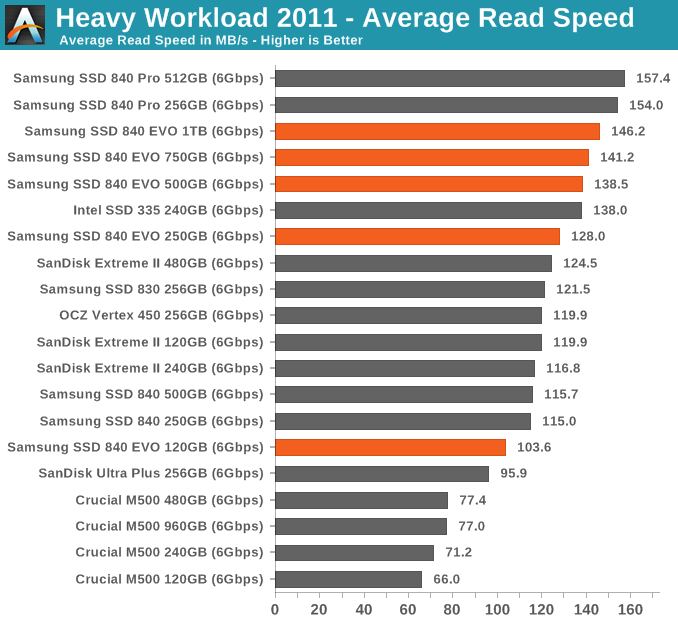
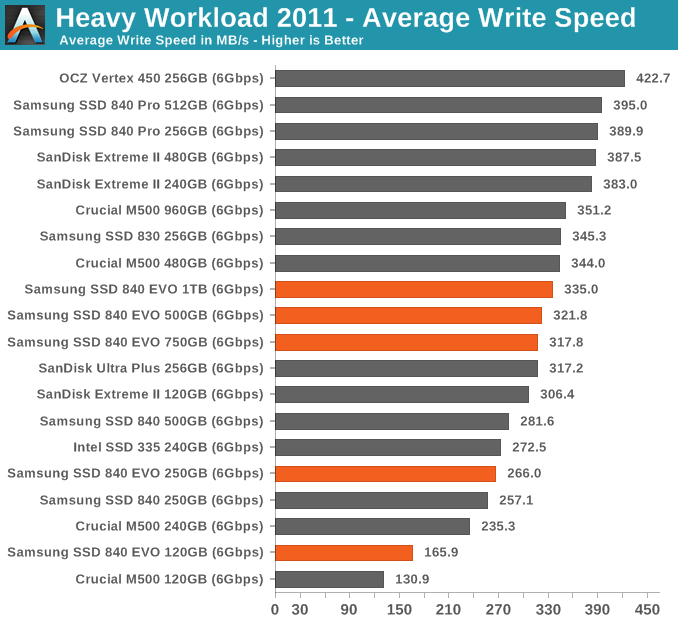
AnandTech Storage Bench 2011 - Light Workload
Our new light workload actually has more write operations than read operations. The split is as follows: 372,630 reads and 459,709 writes. The relatively close read/write ratio does better mimic a typical light workload (although even lighter workloads would be far more read centric).
The I/O breakdown is similar to the heavy workload at small IOs, however you'll notice that there are far fewer large IO transfers:
| AnandTech Storage Bench 2011 - Light Workload IO Breakdown | ||||
| IO Size | % of Total | |||
| 4KB | 27% | |||
| 16KB | 8% | |||
| 32KB | 6% | |||
| 64KB | 5% | |||
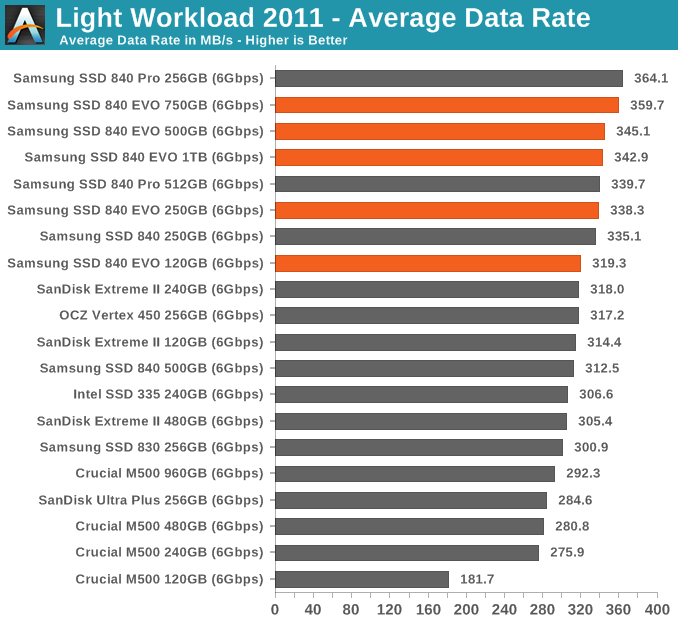
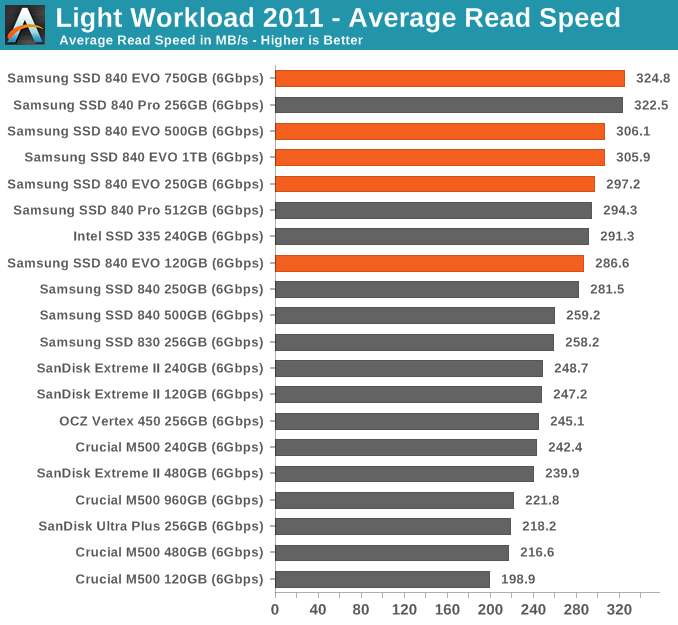
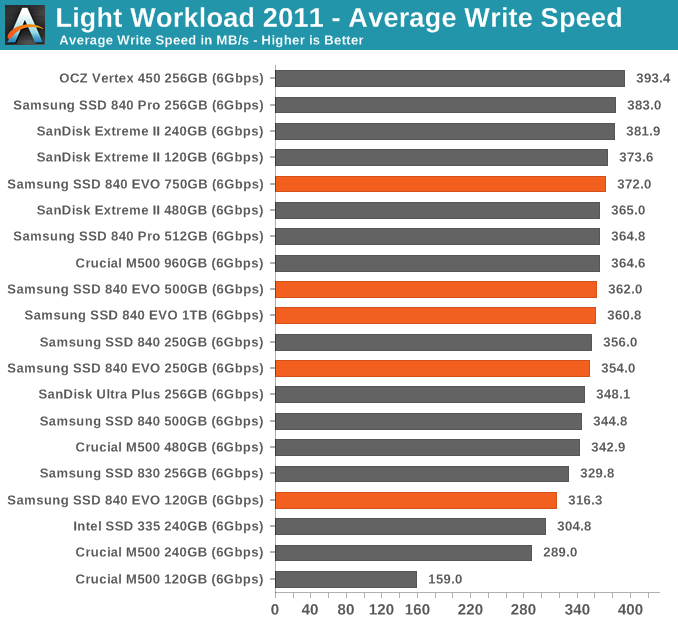










137 Comments
View All Comments
halbhh2 - Saturday, July 27, 2013 - link
Exactly. I found that even moving up from 8GB to 16GB had a great effect for me with an old Samsung F3 hard drive. The difference: after just 30 minutes from boot, loading an often used program like iTunes (for podcasts) was very similar to the speed on my laptop which has an 830 SSD and only 4GB. Both load in about 4 seconds, and the 16GB desktop loads so fast because it has had time to cache a lot of iTunes. Before the ram upgrade, that load time for iTunes on the desktop computer was about 14 seconds. Quite a difference due to windows 7 caching. The extra improvement I'd get from installing an SSD onto the desktop computer now would be modest, since I usually only need to reboot once or twice in a week. Still, the sweet spot of price/performance for me is approaching, probably around $60-$70, and that won't be long.Klimax - Sunday, July 28, 2013 - link
It's in wrong place. Unlike OS level caching (at least in Windows), which is in cooperation between memory manager, cache manager and file system driver, this is too low in the chain and sees only requests but nothing else and also takes memory from OS and takes too few.Coup27 - Thursday, July 25, 2013 - link
Typo: "although I wouldn't recommend deploying the EVO in a write heavy serve Microsoft's eDrive standard isn't supported at launch"Excellent article. Samsung continue to push SSDs and I'm really excited about RAPID. Is the 840 Pro due for a successor any time soon? I am selling my current ATX Sandy Bridge + 830 and getting a mITX Haswell + (840 Pro?) and want the fastest Samsung consumer SSD available and I'd be gutted to buy an 840 Pro to see it's successor released a few weeks later.
vLsL2VnDmWjoTByaVLxb - Thursday, July 25, 2013 - link
Another typo last page:"Even though its performnace wasn't class leading, it was honestly good enough to make the recommendation a no-brainer. "
JDG1980 - Thursday, July 25, 2013 - link
Will there be an 840 EVO Pro coming out later? To me, TLC is still a deal-breaker.By the way, what happens if power goes out during a TurboWrite (before the data has been written to the normal storage space)? Does this result in data loss, or, worse, bricking? I'd suspect Samsung at least avoided the latter, but I'd like to see some confirmation on this.
sherlockwing - Thursday, July 25, 2013 - link
I guess you didn't read the Endurance part of the review? Even if you write 100GiB a day all of those drives last longer than their warranty( 3 years), that's more than enough endurance.Coup27 - Thursday, July 25, 2013 - link
Some people just don't want to accept the facts. TLC could get to 99.9% of MLC endurance and people would still want MLC. I've been deploying 840's in a light duty enterprise environment and they've been fine. The only reason I use MLC at home is because I want the absolute fastest performance and I can afford it, not that I actually need it.Oxford Guy - Thursday, July 25, 2013 - link
The SanDisk Extreme 240 was just on sale for $150. TLC NAND still seems like a solution in need of a problem.Spunjji - Friday, July 26, 2013 - link
You can approach TLC pricing with an MLC drive in a sale, but the fact remains that when it comes to actual sustainable production pricing TLC NAND has a 50% density (and thus manufacturing cost advantage) over MLC. Given that NAND price determines drive cost and drive costs are the primary barrier of entry to SSDs, I'm fairly sure it has a problem to solve.FWIW I have not seen any drive touch the 120GB 840's price here in the UK, on sale or otherwise.
Oxford Guy - Friday, July 26, 2013 - link
However, there is also the problem of increasing latency and lifespan from node shrinkage.